Part 1: Operation Dragonfly
Air Refuelling support of the United Kingdom Air Defence fighters.

Crew:
During the 1970s, RAF Marham’s Tanker Force provided the Air-to-Air Refuelling support of our Air Defence (AD) fighters for the defence of the United Kingdom. On a 24-hour basis, Tankers could be called up to support ‘Operation Dragonfly’. This was the code name for the operation mounted in response to a hostile penetration of the UK airspace, usually by the Soviet long-range bomber and reconnaissance aircraft. The iconic Tu-95 ‘Bear’, M4 ‘Bison’ and Tu-16 ‘Badger’ frequently probed the 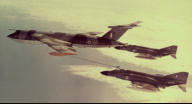 Iceland/Faroes gap to test the resolve and capabilities of the Northern AD Radar Units. Superbly equipped to respond to these intrusions in the mid 70’s were the Lightning F6s and Phantom FGR1s of 11 Group. Equipped with not only air-to-air missiles but also 30mm Cannon, both aircraft were superbly adapted to the AD Role.
Iceland/Faroes gap to test the resolve and capabilities of the Northern AD Radar Units. Superbly equipped to respond to these intrusions in the mid 70’s were the Lightning F6s and Phantom FGR1s of 11 Group. Equipped with not only air-to-air missiles but also 30mm Cannon, both aircraft were superbly adapted to the AD Role.
However, the supersonic dash concept utilised to great effect to intercept the inbound intruders always left the Lightning in particular perilously short of fuel. At the first sign of a potential breach of the UK’s defensive shield, Marham’s tankers would be called upon to extend the range and endurance of our fighters, and generate Continuous Airborne Patrols (CAP). In this way, the AD fighters could be kept on task by sequential refuellings whilst the intruders were intercepted and kept at bay. Where a ‘Dragonfly Mobile’ was generated, any available airborne tanker around the UK could be asked to respond immediately. If two K1s were engaged in mutual refuelling practice over the North Sea for instance, then the two aircraft would effect a maximum transfer of the combined available fuel so that the newly filled tanker could then back up and assist the scrambled fighter(s).
Back on No 214 Sqn as a new fully operational Captain, I had flown a number of Dragonfly call outs. On 16 September 1975, my crew was tasked to deploy to RAF Leuchars because of intelligence received of a potential threat of an airspace violation. In the early hours of 17th September, we were scrambled on Operation Dragonfly. Our ‘trade’ of course would be airborne from their QRA sheds well before we had even got to our combat-readied aircraft. Wiping the sleep from my eyes after a disturbed rest in our Spartan quarters, I donned my immersion suit as rapidly as I could. The proximity of our waiting aircraft left but a short sprint to the open cockpit do or. Our crew chief (who usually accompanied a detached aircraft) frantically removed the pitot covers and static vent plugs before he clambered aboard and secured the door. After a rapid engine start, we raced off in hot pursuit after our armed escort heading due North. Recognised for its rather laboured take off performance, once airborne, the Mk 1 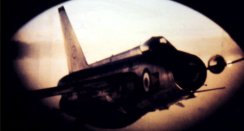 Victor’s sleek aerodynamic profile permitted a high Mach number cruise at a speed close to the speed of sound. By the time we had raced past the Shetland Islands, we were informed our single Lightning was heading back to us for much needed fuel. With wing hoses trailed, our chick was offered his choice of hose and promptly filled to full.
Victor’s sleek aerodynamic profile permitted a high Mach number cruise at a speed close to the speed of sound. By the time we had raced past the Shetland Islands, we were informed our single Lightning was heading back to us for much needed fuel. With wing hoses trailed, our chick was offered his choice of hose and promptly filled to full.
No sooner had he been directed back to his prey, when the radar unit advised us of a further enemy contact. Unlike our cohort whose aircraft was fitted with a pair of Red Top infrared missiles, our steed was fitted neither with an offensive capability nor passive protection! Nevertheless, where multiple contacts appeared, it was not unusual for the Victor to be tasked to close in on additional contacts if the controller found himself with only one interceptor. Accordingly, and under the initial direction of our military radar unit, we were directed towards the 2nd bogie. Before long, I was able to identify not one but a further two Bear ‘D’ models, with tail numbers 30 and 36 respectively.
This regular confrontation may have been interpreted as sabre rattling in the ‘Cold War’ years. Nevertheless the sight of a supersonic fighter in close echelon, bristling with lethal air-to-air missiles, was more than enough to convince the mighty turboprops to press their luck no further. What they 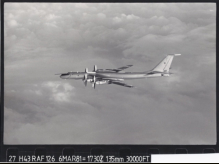 thought when faced with the futuristic shape of the Handley Page Victor no one knows! We watched them turn for home. After loitering for a short period of time to ensure they were not intending to return, we were able to recover south without further ado. Ensuring our companion was satisfied that he needed no more fuel, we were able to return to our Norfolk base, after a very satisfying and successful Operation Dragonfly.
thought when faced with the futuristic shape of the Handley Page Victor no one knows! We watched them turn for home. After loitering for a short period of time to ensure they were not intending to return, we were able to recover south without further ado. Ensuring our companion was satisfied that he needed no more fuel, we were able to return to our Norfolk base, after a very satisfying and successful Operation Dragonfly.
Part 2: Operation Tansor
Having spent the best part of 5 years in the Tanker Force flying Mk 1 Victors, I was posted overseas to Northern California as an Exchange Pilot with the United States Air Force. Flying the KC135 Stratotankers of Strategic Air Command, I was able to see the AAR role from yet another point of view – Boom Refuelling – operating with a whole new range of receivers! Once repatriated however, three years later, I changed roles on completion of the Central Flying School to that of a basic jet instructor. I flew the Jet Provost for the next year at RAF Church Fenton. Just prior to my appointment as OC No 2 FTS, I was re-assigned at short notice back to the Tanker Force to fulfil a shortcoming of instructors on the upgraded Mk 2 Victor. As Pilot Leader on No 57 Sqn, I was once again at the home of the Tanker Force at RAF Marham. No 1 Group’s Tankers were still committed to the defence of the UK, albeit the operation was now code-named “Tansor” (Tanker Sortie) in place of Dragonfly. Within less than one month of being declared operational, I found myself responding to my first callout (Tansor ‘Mobile’) whilst refuelling Phantoms engaged in a Tactical Evaluation exercise. Clearly little had changed during the 5 years or so that I had been away!
April 17th was to herald a couple of busy days. Whilst covering the Tansor Static ground alert, my crew was scrambled in the mid hours of the morning. On this occasion, I was to support a couple of Phantom FGR1s of No 43 Sqn (The Fighting Cocks) from Leuchars. With a lot more time to spare before their first supplement of fuel, I was directed across the edge of the North Sea towards another K2, which had finished its detail and was in a position to offer me a useful top up en-route to the operating area. Skilfully directed by the ground based radar unit, I was soon in a position to visually identify my colleague and join up without delay. Turning onto a northerly heading, I slid behind my leader and quickly made contact on the centre-line Hose Drum Unit (HDU). Once our transfer was complete, I dropped back and slid into echelon starboard, and cleared my tanker alongside to turn port about so that I might continue straight ahead. We flew at high speed along the eastern edge of the United Kingdom, intent upon joining the tactical towline that our radar unit would assign to us. I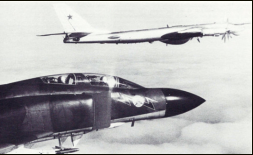 arrived on task to find one of my chicks already waiting for his first onload. His leader had been left on station accompanying a Bear ‘D’ contact.
arrived on task to find one of my chicks already waiting for his first onload. His leader had been left on station accompanying a Bear ‘D’ contact.
Our chick took on a top up so that both fighters would be ideally placed to interchange as required by the developing set of circumstances. With the much greater fuel load of the F4, especially when carrying external fuel tanks, their dependence on a tanker was considerably reduced. It was often felt that the Victor crews always had a much closer bond with the Lightning pilots because of the latter’s more urgent dependency on 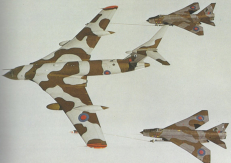 frequent refuelling. It was a fact that no Lightning had ever been left short of fuel and in a position where he was unable to recover to base safely – despite several close shaves!
frequent refuelling. It was a fact that no Lightning had ever been left short of fuel and in a position where he was unable to recover to base safely – despite several close shaves!
The F6 Lightning with a ventral tank (which it shared the Cannon fit) was able to carry around 10200lbs of avtur. Responding to a thirsty interceptor on one occasion, we had raced towards our chick at limiting Mach number and turned in front of him under a hastily executed rendezvous. Desperate for fuel having stretched himself on his last interception, the Lightning pilot wasted no time in connecting with the wing hose. Of all our receivers, the Lightning pilots were unquestionably the most able at ‘prodding’. To be fair, especially at altitude, their aircraft had the most excess power, and it was arguably the most agile despite its bulk. His gratitude was almost audible as the Nav Radar called “fuel flowing” as our receiver took on fuel initially at about 1500 lbs per minute. Whilst in contact of course, the Lightning would continue to burn fuel, which would account for the fact that on completion of the fuel transfer after some 7 or 8 minutes, we had passed him no less than 10600 lbs!
Back on CAP, our Phantoms had returned to their action stations to deal with whatever was thrown at them. Listening on the radar controller’s frequency, it was apparent there were at least 2 bogies by this time. Each F4 had split to shadow their individually assigned targets, and we waited patiently for our next refuelling. Hoses were kept fully trailed during these occasions so that if the receiver returned unexpectedly, we were ready to offer fuel immediately. In the case of the F4, unlike the Lightning, it was often more expedient to transfer fuel into the Phantom more quickly using the centre HDU where transfer rates of up to 4000 lbs per minute could be achieved.
With two chicks on task on this occasion, we chose to leave both wing hoses trailed at the ready to cover all events. It was not unusual for the Phantom to be away from the tanker for up to an hour or so, depending on whether he was loitering on a forward CAP waiting for action, or involved in supersonic dashes to new targets. After the 1st target had been successfully seen off, the lead F4 appeared for his first onload of fuel since departing base. A transfer of around 10000 lbs was passed to our customer before he dashed off to resume his task. There followed a period of inactivity when out of the blue, a third bogie appeared on the scene and the action kicked off once more. To intercept 3 Bear Ds during the same mission was pretty unusual, and demonstrated the lengths to which our Soviet Air Force counterparts would go to test our defence capabilities. However, unlike the ‘Dragonfly’ mission some 6 years earlier, I was not going to get the chance to exercise my intercept skills on this occasion.
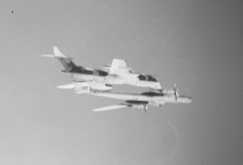 After a brief hectic period when the F4 navigators no doubt photographed their quarry for their respective debriefs, the protagonists duly turned turtle and returned to the northern wastes. Despite waiting on task for a further 30 minutes or so, our returning chicks kindly refused the offer of one final top up, and we left them to their own devices to return to base. Trawling our way back down to Norfolk, we landed after an eventful 4 ¾ hours airborne time.
After a brief hectic period when the F4 navigators no doubt photographed their quarry for their respective debriefs, the protagonists duly turned turtle and returned to the northern wastes. Despite waiting on task for a further 30 minutes or so, our returning chicks kindly refused the offer of one final top up, and we left them to their own devices to return to base. Trawling our way back down to Norfolk, we landed after an eventful 4 ¾ hours airborne time.
Still within the shift time for our Tansor commitment, we combat readied our trusty steed, and returned to the squadron crew room. Barely had we had time for a cup of tea when the balloon went up again. We hurried back to the aircraft, which for some reason had been changed for XL163. By the time we had climbed to our cruising altitude for the second time that day, the evening hues gave way to a dark sky as we once more headed north. Again we were directed to our Leuchars playmates, and set off towards the familiar Iceland/Faroes gap. Whether or not our previous adversaries were playing cat and mouse will never be known. All I can say is that on this occasion, we were to draw a blank, with no interceptions made by our Phantom buddies. Nevertheless, to make certain, we patrolled the night 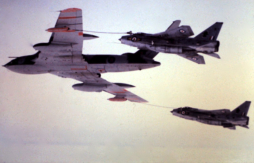 skies on task for the best part of another hour. For the second time that day, I was to claw my way back to our base, on this occasion after a fruitless but tiring 4 hrs 50 mins. At least we would be able to retire to our beds for some sleep.
skies on task for the best part of another hour. For the second time that day, I was to claw my way back to our base, on this occasion after a fruitless but tiring 4 hrs 50 mins. At least we would be able to retire to our beds for some sleep.
My logbook shows that on the following day, my crew was launched yet again for the 3rd time on one further Tansor Static callout. Again on that occasion, I was to receive a top up from a tanker nearby before setting off to the northern reaches. As was often the case, there were to be no interceptions once more. Frequently as soon as our Soviet cousins got wind of the responding fighters of 11 Group, they shied away and avoided the ignominy of facing a menacing adversary in the form of one of the RAFs interceptor force. Tansor missions were continued to the time of the retirement of the venerable Victor Tanker, whose record in this pivotal and significant role was always acknowledged as being second to none.
